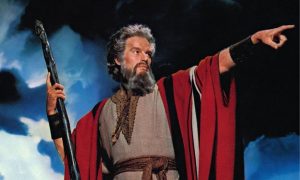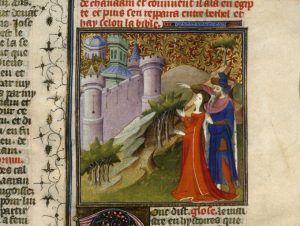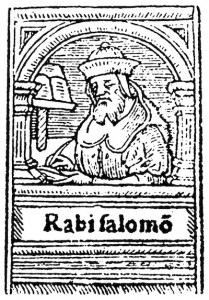In a previous post I wrote about the influence of Jewish exegesis in the development of fictionality, that is, those aspects of prose fiction that serve to enhance the as-if function of fiction and make possible the suspension of disbelief required of audiences of fiction. In the past post I discussed examples drawn from the Castilian translation of the Song of Songs included in the General estoria of Alfonso X (r. 1252-1284), a universal history in the Castilian vernacular that relates human history from creation through the reign of Alfonso’s father, Ferdinand III (known since the seventeenth century as ‘The Saint’ and after whom Los Angeles’ San Fernando Valley aka ‘The Valley’ is named).
Here I will examine a few examples drawn from the Abraham cycle of the General Estoria of Alfonso X in which Jewish exegesis appears to shape the Castilian vernacularization of the Vulgate text, paving the way for later Castilian writers in their vernacularization of exempla and other Latin texts, and ultimately, for the development of a more capacious Castilian literary register used to describe fictional worlds.
The work’s prologue spells out the goals of the text: men would like to know the past, present, and the future, but can only know the past. To this end they wrote many books recording the deeds and stories of great men, in which group he includes ‘God, the prophets and the saints, as well as kings, high nobility, knights, and commoners’ (“de Dios e de los profetas e de los santos, e otrossí de los reyes, e de los altos omnes e de las cavallerías e de los pueblos”) (Alfonso X , 1: 8).
The purpose of these positive portraits is exemplary, so that “men might take the example in order to do good,” (“e de los fechos de los malos que recibiessen castigo por se saber guardar de lo non fazer”) (Alfonso X , 1: 8) while the bad deeds of biblical characters serve as a reminder of what not to do. This approach puts the author Moses in same category as Herodotus, Livy, and Josephus:
[I] had them gather many texts and histories of the deeds of antiquity; I selected the truest and the best of those of which I had learned and made this book. And I also had them put in it all the best stories from the Bible, of the great things that happened throughout the world from when it began up until our own times.
ove fecho ayuntar muchos escritos e muchas estorias de los fechos antiguos escogí d’ellos los más verdaderos e los mejores que ý sope e fiz ende fazer este libro. E mandé ý poner todos los fechos señalados tambien de las estorias de la Biblia como de las otras grandes cosas que acaecieron por el mundo desde que fue començado fasta’l nuestro tiempo. (Alfonso X , 1: 8)

It’s El Cid! No, wait….
Charlton Heston as Moses Source: http://www.christianvoice.org.uk/
The truth claims made by the General estoria, as a work of historiography, are more similar to those of the modern novel than they are to those of modern history. Medieval historiography does not aspire to an empirical referentiality. It does not intend to recreate or represent historical events in the same way we have come to expect of modern historiography. Because medieval historiography and biblical narrative both made similar types of truth claims, their combination in a text such as the General estoria is not problematic as it would be today. And because Alfonso’s goal was to produce a universal, rather than eschatological or Christological account the past, the inclusion of pagan Classical, Muslim, and Jewish courses strengthens, rather than compromises, the text’s authority.
In this reading of the second part of the Abraham cycle, my approach has been to observe where the General estoria differs from the Vulgate, and from there where it differs from its most heavily used sources: Petrus Comestor’s Historia Scholastica, Josephus’ Antiquities, and Godfrey of Viterbo’s Pantheon.
As I found in my study of the Jewish sources of the General estoria’s translation of the Song of Songs, the evidence suggests that the compilers of the General estoria rely on Jewish sources in order to develop the fictionality of the narrative; that is, in order to augment and enhance the Vulgate narrative by focusing on aspects that are suggestive of modern ideas of fiction: characterization, motivation, and narrative coherence or continuity.

‘Hagar Leaves the House of Abraham’, Peter Paul Rubens, 1615- 1617 Source: http://www.womeninthebible.net/
Our first example of the influence of Jewish exegesis on the General Estoria’s Abraham cycle is in its characterization of Sarah’s servant Hagar. Now pregnant with Abraham’s son Ishmael, while Sarah remains barren, Hagar becomes disdainful and haughty toward her mistress. You can see the sources at number three on your handout.
The Vulgate mentions only that she is disdainful (“despexit dominam suam”) but the General estoria goes into a bit more detail, relating that she ‘began to be unruly and to sniff at her mistress and disdain her words’ (“començó a seer loçana e a despreciar a su señora e desdeñar la su palabra”) (Alfonso X 5:26, 245). Comestor, one of the General Estoria’s most common Christian sources, echoes the Vulgate with out further comment, but the Midrashic sources brought together in Ginzburg’s Legends of the Jews dramatize Hagar’s haughtiness in detail:
When noble matrons came to see Sarah, she was in the habit of urging them to pay a visit to “poor Hagar”, too. The dames would comply with her suggestion, but Hagar would use the opportunity to disparage Sarah. “My lady Sarah,” she would say, “is not inwardly what she appears to be outwardly. She makes the impression of a righteous, pious woman, but she is not, for if she were, how could her childlessness be explained, after so many years of marriage, while I became pregnant at once? (Ginzburg 201)
The Jewish exegete Rashi, whose commentaries were read widely in Spain during Alfonso’s time, also cites this Midrash in his commentary on Genesis.

Sarah and Abraham
Bible traduite en français par Jean de Sy. 15thc. BNF f.14r Source: Bibliotheque Nationale de France http://gallica.bnf.fr
At other times, the compilers enrich the version found in the Vulgate in order to explain the motivations of the characters, just as the Midrash often does. When Abraham and Sarah first arrive in Egypt, the news of Sarah’s beauty travels quickly. The Vulgate reports simply that Pharaoh’s courtiers told him about Sarah. Josephus adds a bit more detail, explaining that the Pharaoh was not content with second hand reports and insisted on meeting Sarah in person (Josephus I.8.1, 27). Comestor and Godfrey of Viterbo are silent, but the General estoria goes into a bit more detail to explain the courtiers’ motives, relating that “When the courtiers of Egypt saw her, they then tried to ingratiate themselves with the king, telling him how they had seen a young lady, a pilgrim, who was very beautiful, and praised her to him quite a bit.” (“los poderosos de Egipto pues que la vieron por engraciarse dixieron al rey cómo vieron allí una manceba que andava como peregrina e era muy fermosa, e alabárongela mucho”) (Alfonso X 5:4, 212). On this detail both Rashi and the thirteenth-century Catalan exegete Nahmanides both state explicitly that the courtiers reported on Sarah’s beauty because they thought the Pharaoh might choose her for his harem, again emphasizing motive.
One of the other concerns of the compilers is to provide more narrative coherence between otherwise discrete episodes of the Old Testament, in order to build a more comprehensive and interrelated storyworld. This is also characteristic of the prose fiction of the late Middle Ages in its development toward the modern short story or novel. The compilers here provide details drawn from Jewish sources that connect episodes that in the Vulgate are unrelated.

Isaac Isaacsz, Pharaoh Returns Sarah to Abraham, 1640. Oil on canvas, Rijksmuseum, Amsterdam. Source: https://www.rijksmuseum.nl
Sarah’s servant Hagar, mother of Ishmael, was given to her as a gift from Pharaoh when she and Abraham left Egypt. This detail is missing from the Vulgate, and Josephus and Comestor likewise do not mention it. The General estoria explains that Hagar was in fact one of the servants given to Abraham and Sarah by Pharaoh:
Among the riches and the servants male and female that King Pharaoh, his ministers and his friends gave to that Abraham and his wife Sarah and his nephew Lot, he gave Sarah, out of the great love he had for her, a young girl servant who was very close to him, and begged her to let him demonstrate his great love for her; and Sarah happily received the servant from him and brought her with her. And this servant was Hagar, of whom we shall speak further on.
E entre las riquezas e los siervos e las siervas que dend sacaron Abraham e Sarra su muger e Lot su sobrino que les dio el rey Faraón e sos privados e sos amigos dio el rey a Sarra por el grand amor que oviera d’ella una sierva mancebiella, e que era muy su privada, e rogóla que le fiziesse algo por el su amor; e Sarra recibiójela de grado, e levósela consigo. E esta sierva fue Agar, de quien fablaremos adelante. (Alfonso X 5:6, 215)

Fragments of the Qumran Genesis Apocrypha Plate 647 1Q20 1Q apGen
Source: http://www.deadseascrolls.org.il/
The text here again works to resolve the gift of Hagar from the Pharaoh to Sara. In the Rabbinic mind, it is to establish legal precedent for the Israelites’ claim to the land of Goshen. But for the compilers of the General estoria, unconcerned about legitimizing Jewish claims to this or that parcel of land, it is about fictional logic; they want to explain why Pharaoh gave Sara a parting gift. In fictional terms, this gesture serves to connect Hagar with the Egypt episode, as well as to deepen Pharaoh’s characterization, as it humanizes the love (lust) that Pharaoh had for Sarah. Furthermore, it uses the reader’s familiarity with Hagar to think ahead to her eventual expulsion and suffering in the wilderness, further deepening the characterization of both servant and mistress. In Jewish sources, the tradition of Pharaoh’s donation of Hagar to Sarah is quite old, first witnessed in the Apocrypha of Genesis in Qumran 1, but the more likely source for the compilers of the General estoria is again the Pirkei de Rabi Eliezer, which describes Hagar not only as a servant of Pharaoh, but as his own daughter by a concubine (Eliezer ben Hyrcanus. 26:2, 190).

Pudding
Source: https://silk.com/
By way of conclusion, we must say that these examples are suggestive, but not yet conclusive. The very circumstances of the compilation of the General estoria work against positive identification of its Jewish sources. The compilers often identify Christian and Muslim authorities, while specific Jewish sources aside from the Hebrew Old Testament, or rather the author Moisés, are not. Once in a while the compilers say “the Jews say” or “the Jews believe,” but for the most part they say nothing. Occasionally a when the compilers say “some say” the “some” turns out to be a Jewish source. We have no record of the working habits of the teams who compiled the General estoria and relatively little information about which versions of which exegetical texts a Jewish translator working for Alfonso might have had access to. Still, as they say, the proof is in the pudding. I am increasingly convinced that the compilers made regular use of Jewish exegesis in their adaptations, and further study of the biblical material in the General estoria will teach us more about this aspect of the text’s composition, an aspect that may teach us a great deal about the role of anonymous Jewish intellectuals in the birth of Castilian fiction.
Works Cited
- Alfonso X. General estoria. Ed. Borja Sánchez-Prieto. 10 vols. Madrid: Fundación José Antonio de Castro, 2009. Print.
- Eliezer ben Hyrcanus. Los capítulos de Rabbí Eliezer = Pirqê Rabbî ʼElîʻezer. Trans. Miguel. Pérez Fernández. Valencia: Institución S. Jerónimo para la Investigación Bíblica, 1984. Print. Biblioteca midrásica ; 1; Biblioteca midrásica ; 1.
- Josephus, Flavius. Antiguedades de los judíos. Trans. Alfonso Ropero Berzosa. Vol. 1. Barcelona: CLIE, 1988. Print.
This post is a version of a paper I wrote for a session on Jewish sources in the Biblical translations in the General estoria for the Cultural “Symbiosis” International Research Consortium: Humanities, Ideas, and Power in Motion (Sevilla, May 16-18, 2017) organized by Francisco Peña Fernández (UBC Kelowna). Many thanks to my research partner David Navarro (Texas State San Marcos), who read the paper when I was not able to attend. This conference was part of the larger project, “Confluence of Religious Cultures in Medieval Iberian Historiography: A Digital Humanities Project” supported by funding from Social Science and Humanities Research Council, Goverment of Canada.



![Hardly photographic [Renoir, Chestnut Trees in Bloom (1881) Source: wikimedia commons]](https://davidwacks.uoregon.edu/files/2016/07/renoir-2hgul6l-300x235.jpg)

![True, but not Real [Lancelot and Guinevere, north-eastern France or Flanders (St Omer or Tournai), 1316, Additional 10293, f. 199. source: British Library, Medieval Manuscripts blog]](https://davidwacks.uoregon.edu/files/2016/07/prose-lancelot-28mujtc-233x300.jpg)
![David, who's your tailor? [Photo: David loads provisions in the Maciejowski Bible, New York, Morgan Library Ms M. 638, f. 27 Source: wikimedia commons]](https://davidwacks.uoregon.edu/files/2016/07/david-29k8dnw-300x190.jpg)